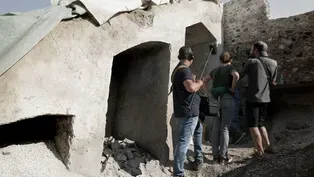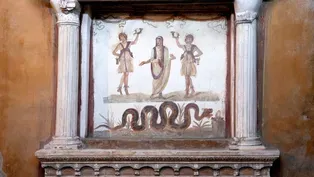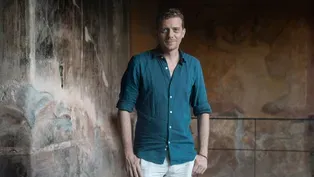
The Black Frescoes
Clip: Episode 3 | 3m 18sVideo has Closed Captions
Pompeii’s director, Dr. Gabriel Zuchtriegel, reveals painted frescoes on black walls.
Pompeii’s director, Dr. Gabriel Zuchtriegel, reveals an incredible discovery in a room in the new wealthy house. Intricate frescoes depicting scenes from Homer’s Iliad painted on black walls.

The Black Frescoes
Clip: Episode 3 | 3m 18sVideo has Closed Captions
Pompeii’s director, Dr. Gabriel Zuchtriegel, reveals an incredible discovery in a room in the new wealthy house. Intricate frescoes depicting scenes from Homer’s Iliad painted on black walls.
How to Watch Pompeii: The New Dig
Pompeii: The New Dig is available to stream on pbs.org and the free PBS App, available on iPhone, Apple TV, Android TV, Android smartphones, Amazon Fire TV, Amazon Fire Tablet, Roku, Samsung Smart TV, and Vizio.
Buy Now
Providing Support for PBS.org
Learn Moreabout PBS online sponsorshipNARRATOR: But the vibrant, brightly-colored walls of the living room are in stark contrast to the room next door.
Here, some truly astonishing decorations are emerging from the pumice.
DR. GABRIEL ZUCHTRIEGEL: It's fascinating, the quality of the painting is extraordinary.
And you see the three figures... a dog, a hunting dog, which is also very... the details, the eyes, everything.
And you see that, for example, her dress, it's almost transparent.
And you see her expression and the hair.
It's all very, very beautiful.
NARRATOR: The scene is from Homer's Iliad.
It shows Paris, the prince of Troy, when he first meets Helen, the most beautiful woman of the Greek world.
DR. GABRIEL ZUCHTRIEGEL: It's kind of unique, I say, the composition, right.
And so they are saying, we are not using one of the typical mythological scenes which are very, very common in Pompeii, but it's something, you know, a bit more special.
And this shows also the education, the culture of the people who lived here, or pretend to have this culture, who knows, right?
What's also interesting, it's all painted in black.
This usually was for rooms which were being used in the winter.
And so in the evening, you would have to use lamps.
And the smoke of the lamps tended to blacken the walls.
And so Vitruvius, the author, suggested, well, the rooms you're using in the winter where you have to use lamps, paint them in black so you don't see the smoke on the walls.
NARRATOR: On another wall, the god Apollo, complete with his lyre, is trying to seduce his priestess, Cassandra.
DR. GABRIEL ZUCHTRIEGEL: I think it often was, first of all, showing off one's education and, you know, culture.
And so you'd say, you know, I know Greek, I know Greek culture, I paint my house with Greek images.
So you always have to imagine that this is being used during a practice which is social practice, people meet here, eat together, and often you have philosophical, political, cultural conversation.
A Deadly Pyroclastic Flow Hits Pompeii
Video has Closed Captions
Volcanologist Professor Chris Jackson discovers evidence of the deadly pyroclastic flow. (2m 24s)
Video has Closed Captions
In the wealthy house, archaeologist discovers two three-dimensional snakes. (2m 28s)
Video has Closed Captions
In Pompeii, the biggest dig in a generation reaches its climax with thrilling discoveries. (30s)
Providing Support for PBS.org
Learn Moreabout PBS online sponsorship













